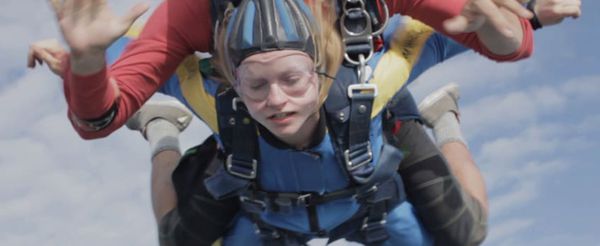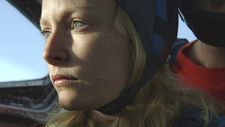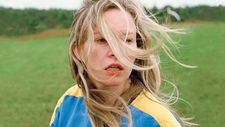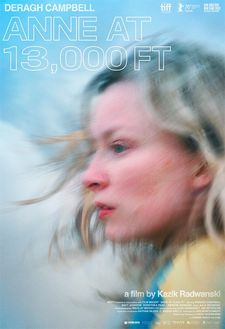 |
| Anne At 13,000 Ft |
The story of a young woman who discovers that she feels more at home in the air than on the ground, Anne At 13,000 Ft is a small film making a big impression on audiences and critics alike. Directed by Kazik Radwanski and starring Deragh Campbell, it’s also film with an intriguing story behind it, so when I met up with Kazik and Anne I began be asking them which came first, the story or its central character?
“I suppose you could say story first,” says Kazik. “But they were both kind of evolving and in conversation. There was a screenplay and a lot of the story elements were in the film, and Deragh and I had quite a lot of conversations and did a fair amount of research. But we really had to start over again and learn from the character. We shot this film over quite a long period of time, it was two years. So I think a lot of the character comes from those two years of us trying things and doing exercises.”
 |
| Preparing for the big jump |
“Yeah, I would agree with what Kaz said,” says Deragh. “I guess it's a matter of when you know what the story is, then you kind of have the character in it, and you see how they respond to it. And you get to know the character gradually in response to the story. So I guess maybe the the only thing that might differ from a slightly more traditional approach to creating a character is that rather than completely understanding who the person was, I think it was more a matter of being in the situation, and that eventually allowed me to understand the person a little bit more.”
Did that mean going back and forth and reshooting or reshaping scenes after learning more?
“Yeah, I would say that if something was interesting, we'd want to follow that lead,” says Kazik. “So, yeah, sort of growing the character. If there was a territory that required further investigation, we would go in that direction a bit more. Some of the supporting characters, their roles grew, because we were led in that direction. My feeling on set is that if something interesting happens, I want to do more, or I want more takes of that. If that was interesting, how much further can people go with it?
“I think that we have that freedom to keep following those leads. Rather than story, I suppose I think of situations or you can even maybe say conflicts, and then have an idea that there might be different perspectives or attention there. And then it's a matter of seeing how people interact and those tensions.”
Did that affect how they worked with the child actors in the film? I imagine that a lot of what they came out with was not scripted.
“Absolutely, yeah,” he says. “And, yeah, Deragh has a co-writing credit on the film, but I think we might have been able to give one to Sharkboy Oliver – all that dialogue, all that expertise, he brought to the set with him. When we were auditioning, he would just not stop talking about sharks, and he had like a real passion for it. So that's something that we would incorporate into the scenes or have space for that, because we’d just know how on he would be. But yeah, we work with children in a few different ways.
“There was almost this sort of mini troupe of child actors that we had, essentially a classroom of child actors that we would work with. It'd be pretty freeform sessions about two hours every Saturday, we’d just return and have an imaginary classroom. But as we worked with them more and more, it became quite precise or complex. We would, from week to week, be looking for one reaction, or really breaking down some of those scenes. Towards the end, the scene with the mercury story about the cat is quite constructed, at least in terms of the shots. But then other moments were very freeform, almost documentary-like. Deragh volunteered for a while and that grew into us just being able to follow her into a classroom and shoot documentary-like moments with children. The opening scene with the butterfly is an example of that, and allowing for more spontaneous moments with the child actors, as well.”
 |
| Lost on the ground |
I ask Deragh if doing the work with the children like that affected how she approached her character, who is quite childlike in a lot of ways.
“I think that, in a way, there's something in what child actors can do, that you can strive toward as a performer,” she says. “Just the idea of being unselfconscious and that there isn't your real self and a presented self, it's all one.” She references one critic’s observation that Anne seems to lack self-consciousness, like children do, so she’s constantly putting herself forward. “But what she has, that maybe children don't have, is a history, She has lived a life that has wounded her. I think that creates like a strange sort of, like, open and wounded person, sort of like a child adult.”
What was it like playing a role like that? Was it emotionally difficult?
“I think because it was so much about responding to the circumstances, it was probably more of a release than it was a punishment,” she says. “In performing the only thing that can be difficult for me is, you know, it's always a goal to be unselfconscious, but that isn't always possible. Like some days, you're a bit more in your head or you feel like you're not doing a good job, or something like that. So I think any of the times that I was able to feel, like, really focused on the situations that Cass had constructed, that was always a real pleasure.”
I tell Kazik that I was interested in the way that he used close up in the film. It seemed very childlike in terms of getting straight up into people's faces with a kind of lack of boundaries. Was that something he was aiming for?
“Yeah,” he says. “I mean, it’s funny, it's something it's a it's been a part of my approach with all my films. My other two features and a number of shorts. But yeah, I think I think the origin of it comes from me looking for some sort of vitality, especially when I was making my very first films. It was really exciting as a young filmmaker. Once I got to the point of making features, and in this film in particular, other aspects of it that I think became hugely important. At times it’s helpful in terms of empathising with someone, but then at the same time, there being something alienating about it as well. The push and pull of being a little too close sometimes or a little overwhelmed, almost the confusion, and that, again, helping with empathy, or how we view a person. We that it felt it feels, you know, truer to life. Or strangely, as as overt as it is, for me somehow it feels fairer, imperfect and kind of overwhelming and confusing.”
That's also in the edit and the way that we keep cutting away from scenes where they don't quite feel finished and zooming into the next thing.
 |
| Anne At 13,000 Ft poster |
“Yeah, yeah,” says Kazik. “The editor Ajla [Odobasic], she's held all my films together. She's a huge part of the process and the decision making and as I alluded to before, yeah, it's been a bit of an evolution. So the opening of this film was quite different than what was in the script. That's something that changed quite a bit, how we entered the film, those really extreme juxtapositions of what Deragh’s doing in the plane and then in the classroom. We experimented a lot in the edit room.”
How did they shoot the the parachute and plane sequences?
“You know, that was a great experience,” he says. “What we quickly learned is that all skydivers are also filmmakers. It’s a big part of jumping, you know: GoPro cameras and recording each other jumping to share what you're doing in midair. So it was really natural. It was awesome learning. We definitely did not know what was possible. And yeah, there was a few failed attempts initially.”
It was Deragh’s first experience of jumping out of a plane, he explains.
“We do have that footage when she's in the plane and about to jump out. That's all very real. And that's her first jump. But yeah, it was a bit of trial and error, so some of the footage in mid air was reshoots. And when Nikolay [Michaylov, the cinematographer] and I saw the footage, we were afraid to tell her that we didn't quite get the shot. So before we told her, I jumped out of the plane for the first time, and we did a camera test on me to figure out how to deal with it then. And then I showed that footage to Deragh and she very graciously agreed to jump again.”
“I mean, I was up for it,” Deragh says. “If anything, I think that the first time I completely erased it from my memory, to do it again.”
“And the second time was incredible too. Because it was your second time we added you fainting in mid-air.”
She nods enthusiastically. “Yeah. Yeah. Which really is the most hilariously literal acting challenge. Being completely in mid-air you really just have this moment to be present and achieve something. You have the time from when you exited the plane to land for this to happen. And truly, if you didn't get it, you would have to jump out of a plane again.”
“I guess that was a difficult dynamic,” admits Kazik. “It's like freefall for about 20 or 30 seconds, and then you float down for 10 minutes. But yeah, it's incredible footage because she did three takes of that on her own in mid-air, just sort of directing herself, fainting and then getting the cameraman to do another take. It's just incredible.”
“I think you should talk to Cinema Guild about about having that...”
“As a special feature,” Kazik completes her sentence. “Mid-air multiple takes.”
We’re almost out of time, so on a final note, I ask how they feel about the reactions to the film that there have been so far.
“It's been quite the journey,” says Kazik. “It's quite a small film that we made two years ago. Covid really amplified this process to where it's been two years now since it premiered. So it's been incredible to see it travel the world – virtually, sometimes. And now we're just so grateful it's going to start hitting actual screens again.”
“I think it's really heartening for people to really connect with the film and connect with the character,” says Deragh. “I mean, I think she's a person who is almost looking to be seen as a protagonist – people giving her that attention. I found it really, really cool how much people have connected with her. I think it shows that people have more of a capacity to feel close to someone that they don't totally understand. In movies, people think that people need someone you can totally understand in order for you to be sympathetic with them. But that doesn't appear to be entirely true.”
Anne At 13,000 Ft opened in New York last week and will hit US West Coast cinemas on Friday 10 September.





















